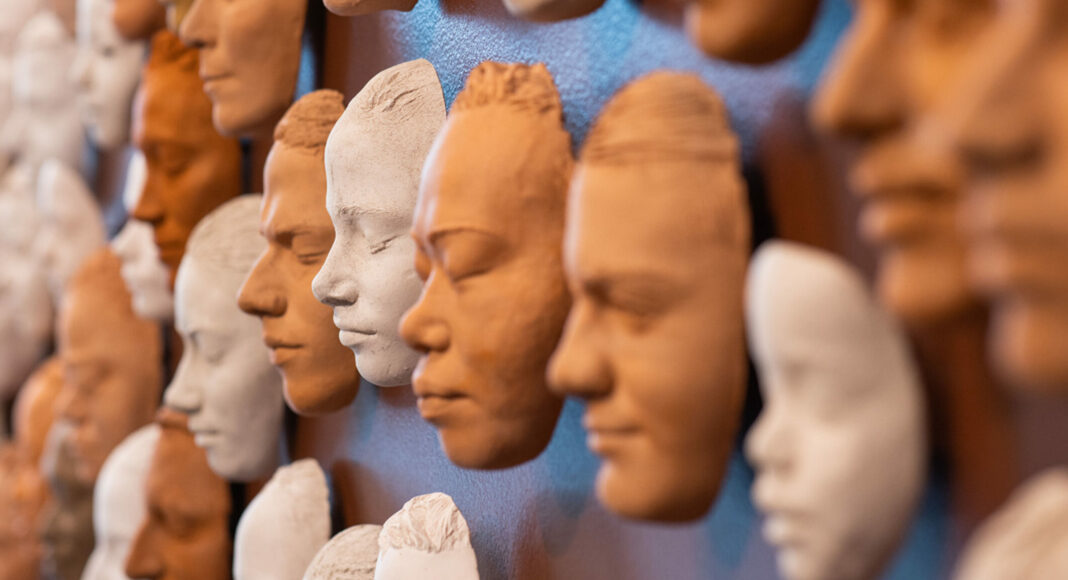Until recently, Ruth Asawa, the Japanese-American artist best known for her intricately looped wire sculptures, has been largely underrepresented outside the Bay Area.
Things began to change in 2020, when the U.S. Postal Service unveiled a series of stamps featuring her designs. This year, Asawa’s work has been included in both the Venice Biennale and at England’s Modern Art Oxford gallery. Now, Asawa is also the subject of the recently opened ongoing exhibit, The Faces of Ruth Asawa, at Stanford University’s Cantor Arts Center, the first of the museum’s trilogy of exhibits dedicated to Asian-American art.
“This has been a very big year for Ruth,” says Aleesa Pitchamarn Alexander, Cantor’s assistant curator of American art. “She’s getting much more exposure and there’s much more awareness around her work than there has been in the past.”
Asawa was born in 1926 to Japanese immigrants who worked on a farm in Norwalk. During World War II, her family was imprisoned in the Japanese-American internment camps. There, Asawa developed a passion for drawing and painting with the help of other interned artists (some of whom were Walt Disney animators). But it was her travels to Mexico and the food baskets she saw in markets that inspired Asawa’s wire sculpture works, which would become her signature medium.
Asawa used iron, steel, copper and brass wires to construct her mostly hanging, woven sculptures. Some are abstract, with multilayered spheres; others resemble natural forms, like tree branches and seaweed.
In the 1960s, Asawa co-founded the Alvarado School Arts Workshop, which brought arts classes to public schools. In the following decades, she was commissioned to make public artworks in San Jose and San Francisco.
In 2019, while consulting with Asawa’s children about installing one of her sculptures in an exhibit, Alexander learned of the nearly 400 ceramic masks the artist had created and hung on the exterior of her home in Noe Valley, where she lived until her death in 2013.
The 233 masks at the Cantor date back to 1966.
“It’s meant to be evocative of the original location on the side of her house, which was covered in shingles,” says Alexander. “It’s also meant to get away from the sometimes sterile, modern art white cube installations. These are deeply personal and domestic objects.”
Asawa used a plaster process to mold the clay masks of various sitters, from her children and students to prominent artists and public figures, like famed New York City Ballet dancer Jacques d’Amboise, actress-playwright Anna Deavere Smith, printmaker Beth Van Hoesen and textile artist Trude Guermonprez.
“There’s a wide range of expressions,” says Alexander. “You get to see the moment she is capturing in time. Some people look very uncomfortable, others look quite serene. Some have little smiles on their faces. They really capture the state of mind of the sitter. They don’t appear as static objects. There’s life to them.”
Cantor pairs the masks with three vessels made by Paul Lanier, one of Asawa’s six children, who mixed clay with the ashes of his mother, father (architect Albert Lanier) and their late son, Adam.
“These are particularly moving objects,” Alexander says. “They really represent full-circle her relationship to the material of clay. It’s a really powerful and thoughtful meditation of what one wants to do with their earthly remains when they move on. Also, the consideration to have them fired in traditional Japanese anagama (wood-burning kiln) is such a wonderful nod to her heritage, and the Bay Area ceramics community.”
Now that the world is waking up to Asawa’s art, Alexander hopes the exhibit will expand our understanding of her role both as an artist and as a Bay Area resident.
“If people know her work, they know of her hanging wire sculpture. But I want people to understand the diversity of her practice and that she was really a force, a Bay Area arts leader and advocate who was very dedicated to the community. The fact that she managed to convince many people to [sit] I think speaks to the level of trust that people had in her as an artist and as a leader.”
The Faces of Ruth Asawa
Now Showing, Free
Cantor Arts Center, Stanford



